Recent activities

In March–April 2017, I returned to Papua New Guinea where we continued exploration in the field as part of the ongoing project, Gingers of New Guinea. Here we started the documentation at the Torricelli Range.

In October 2016, I joined an expediton to Northern Myanmar where I focused on documenting species of gingers and other understorey herbaceous plants.

In July 2016, I assisted the Flora of Nepal Project by training in ginger collecting during an expedition to Eastern Nepal. Here Dr Bhaskar Adhikari and I are describing our collection of a species of Globba.

The project "Gingers of Papua New Guinea" was continued with another expedition in April 2016 where Tapeinochilos hollrungii (Costaceae) was documented in Sandaun Province.

On 25 April 2016, I gave a short talk to 300 students at the Coronation College in Lae about the importance of botanical research and my project on gingers.
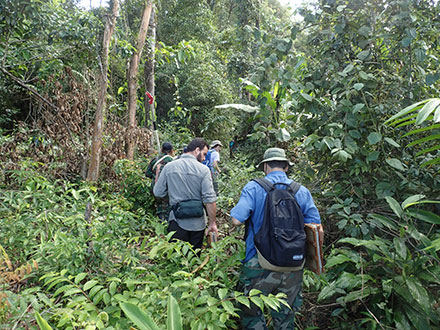
In November 2015, I joined an expedition lead by Ida Theilade to the Cardamom Mts. in Cambodia.
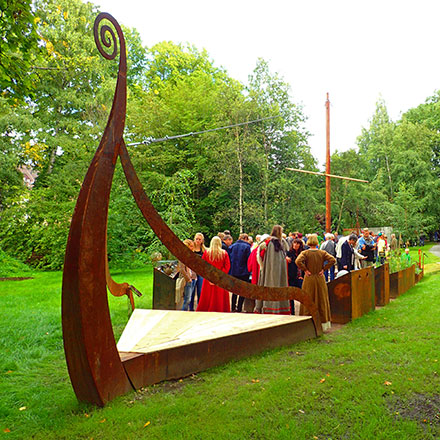
The Viking Garden of the Natural History Museum, University of Oslo, Norway, was officially opened on 31 August 2014 as part of the bicentenary celebration of the Botanical Garden.
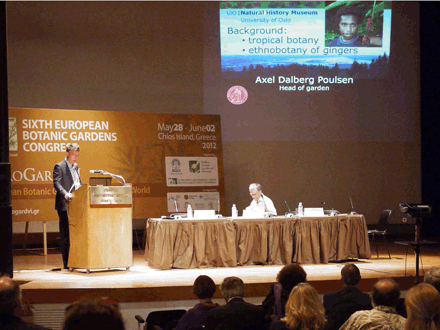
On 29 May 2012, I gave a talk at the EUROGARD VI in Chios, Greece, presenting my ideas of a Viking plant feature in the Botanical Garden in Oslo (Photograph by Harvard Ostgaard, Botanical Software Ltd.).
 On 9 Nov 2011, I gave a talk at the 15th Flora of Thailand Meeting in Chiang Mai on the progress of the revision of the ginger genus Etlingera for the Flora of Thailand.
On 9 Nov 2011, I gave a talk at the 15th Flora of Thailand Meeting in Chiang Mai on the progress of the revision of the ginger genus Etlingera for the Flora of Thailand.
 On 24 Aug 2010, I opened the ginger subsession in the 8th Flora Malesiana Symposium at the Singapore Botanical Garden (photograph by C.L. Lim).
On 24 Aug 2010, I opened the ginger subsession in the 8th Flora Malesiana Symposium at the Singapore Botanical Garden (photograph by C.L. Lim).

In March 2010, I visited the herbarium collections in Basel, Switzerland, and was delighted to find material of a ginger collection made by the Sarasin cousins in Sulawesi in 1894. This collection is a type that is assumed lost when the Berlin herbarium was destroyed in the Second World War. The material in Basel is thus likely to be the only surviving fragment and very important for the correct identification of this species.

On 9 July 2009, I gave an opening plenary speech at the 5th International Zingiberaceae Symposium, hosted by the Xishuangbanna Tropical Botanical Garden, China.
1 September 2008–31 March 2011, I was attached to the Royal Botanic Garden Edinburgh, Scotland, as a Peter Davis Research Fellow (sponsored by The Sibbald Trust) to revise the ginger genus Etlingera of Sulawesi. This work will be based not least on collections made during my fieldwork:
- The first expediton took place in February–March 2008 and was sponsored by The Carlsberg Foundation, Denmark, as part of the Wallacea Project.
- The second expediton was carried out in Januray–February 2009 and was sponsored by Augustinus, Denmark, the Blaxall Valentine Awards, England, and the Davis Expedition Fund, Scotland.
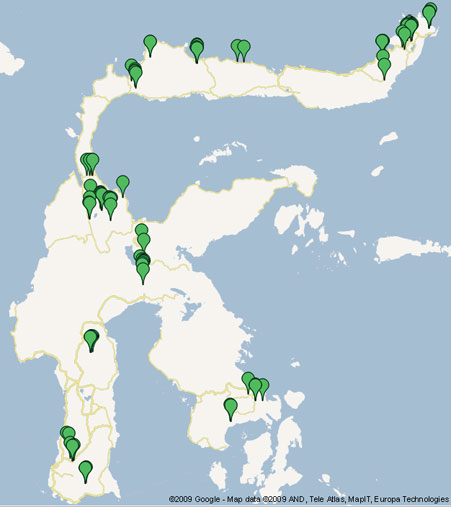
Map of Sulawesi showing all localities where at least one member of Zingiberales was collected in 2008 and 2009.
A total of 174 collections were made of which 80 belong to the genus Etlingera. The revision published in 2012 includes 48 taxa of Etlingera in Sulawesi, some of whcih are shown below.

Etlingera eburnea with plain white flowers, Latimojong, South Sulawesi, January 2009.
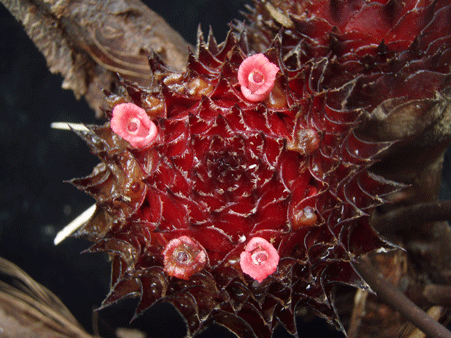
Etlingera aculeatissima with spiny bracts, Takulekayu, Central Sulawesi, January 2009.
: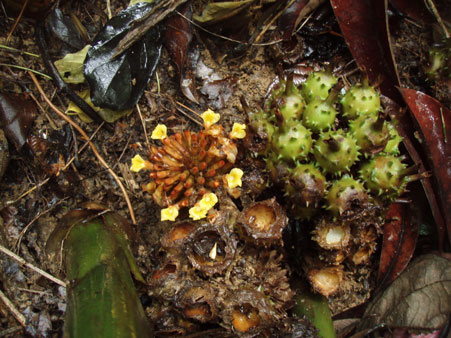
Etlingera calophrys with yellow flowers and edible fruits. Lepo Lepo, Southeast Sulawesi, February 2009.
The fieldwork in 2008 to Sulawesi.
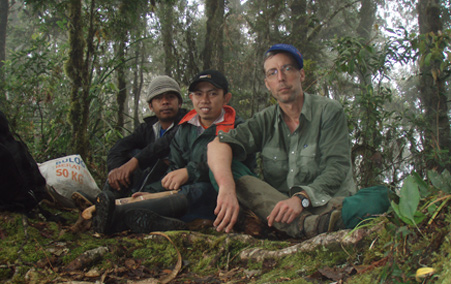
Gunung Nokilalaki, Central Sulawesi, March 2008.
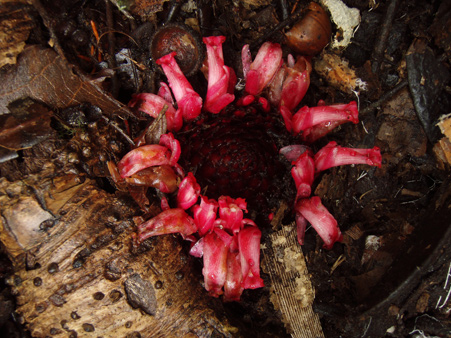
Etlingera flexuosa.

An undescribed species of Alpinia.

Alpinia coeruleoviridis.
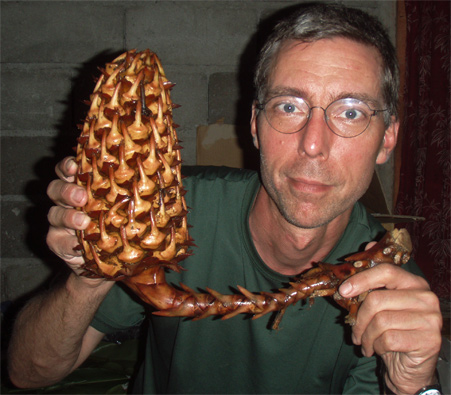
The infructescence of Etlingera tubilabrum may be as big as a pineapple.
1 February 2007 – 31 August 2008, I was based at the Faculty of Life Science (LIFE), University of Copenhagen, Denmark, to teach botany and conduct my own research on gingers and other herbaceous plants. I was involved in teaching botany and developing a number of courses at LIFE including "Botany of Cultivated Plants", "Tropical Botany", "Applied Ethnobotany", "Project and Herbarium", and "Diversity of Plants and Animals". I also did several lectures and events open to the public to create awareness of botany and natural resources.


My research in 2008 was focused on the ongoing project: "Wallacea and the evolution of gingers" sponsored by The Carlsberg Foundation, Denmark.
The project involved fieldwork on gingers in Indonesia and Papua New Guinea in February–April 2008 and lab work on the DNA smaples at LIFE, University of Copenhagen. The activities of the project was extended with the fieldwork in Sulawesi in 2009.

In March 2008, as part of my field based research, we found the common Hornstedtia cyathifera in West Papua (Irian Jaya).

A species of Etlingera from Papua New Guinea, April 2008.
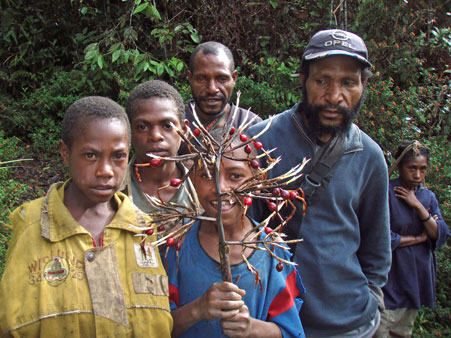
Alpinia stenobracteolata from Simbai, Papua New Guinea, April 2008.
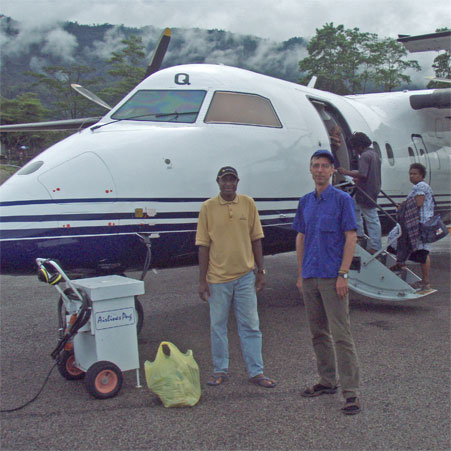
Our departure from Tabubil, Papua New Guinea, April 2008.
|
Recent project: Gingers on Tropical Islands
|
|
|
Papua New Guinea On the first day of Christmas we continued to the Admiralty Islands (Manus Province) and visited the islands of Manus, Rambutyo and Buke. On the latter island, we celebrated New Year's Eve with other participants in Galathea 3 from Moesgaard Museum, Denmark (read my weblog on Jyllandsposten's Galathea website in Danish). |
|
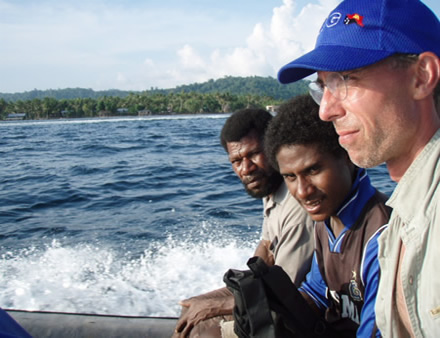 Axel and his merry boat men from Rambutyo on the way to the next destination. |
|
 Billy Bau and Axel at one of the undescribed species that we collected from the highlands of PNG. |
 Billy Bau, botanist from Papua New Guinea Forest Research Institute in Lae, in the process of excavating the subterranean fruits of a new species of Etlingera from the mountainous Bulolo area. |
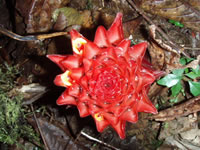 A species of ginger (Etlingera), which may resemble a red pine apple half buried in the ground. |
 In the banana boat on the way to next target island. |
 On look out for a school of skip jacks (tunas) to supplement the evening meal. |
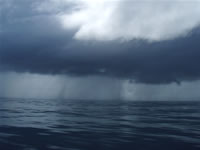 Sometimes a shower at sea was a pleasant cooler in the open banana boat. |
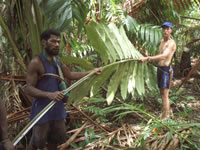 Axel measuring a large wild ginger (Hornstedtia scottiana). |
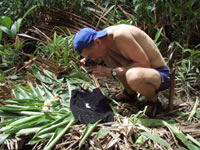 Documentation including photography of the flowers is essential for identification of the ginger species. |
 The leafy shoot of Alpinia oceanica is used by the locals when climbing palms for betel or coconuts. |
 Alpinia oceanica is one of the most common wild ginger species on the outer islands in PNG. |
|
Activities in Solomon Islands, Kolombangara Island |
|
 The search for gingers on Kolombangara Island, Solomon Islands, was completed on 10 Dec 2006. Kolombangara is of volcanic origin and reaches 1770 m. |
|
 From Gizo we organized a 'banana boat' to take us to Kolombangara Island. Gizo is a cozy harbour town where The Galathea 3 Expedition Vessel, Vædderen, arrived on 29 Dec 2006. |
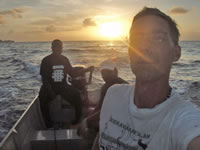 The boat trip to Kolombangara at sunset took 2 hours as we had to go to the northern side. |
 At 1200 m, we found the biggest ginger I have ever seen. Alpinia novae-hiberniae. |
 Alpinia pulchra – a ginger from Kolombangara with red fruits. They go black when ripe. |
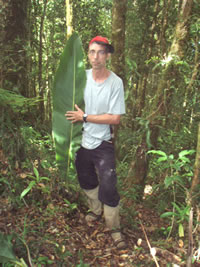 The leaf of the big Alpinia novae-hiberniae can be up to 1.75 m long. |
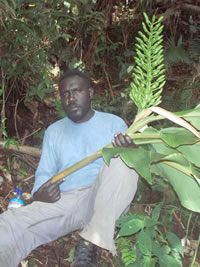 Axel's counterpart, Fred Pitisopa, holding a young inflorescence of Alpinia novae-hiberniae. |
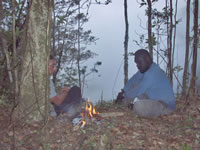 Our camp at 1200 m. |
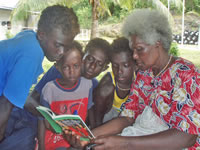 At Nusatupe Airport (near Gizo), we showed a lady and her four grandchildren from Choiseul pictures of gingers. They recognized most of them and could inform us of their local names. The lady also new 4 species of gingers in Choiseul Island that we had not yet seen. |
 |
Back in Honiara, we constructed a device to dry our bulky collections. Our collections have now been posted back to Europe. |
|
Makira Island In total, we have documented 10 species of gingers on both Makira and Kolombangara Islands. All but one has local names and uses and two of them are tabooed. We still managed to collect all without getting into trouble. I still need to consult the literature and type material to establish if any of my collections represent new species. Most of them are at least new to Makira and me.
|
|


